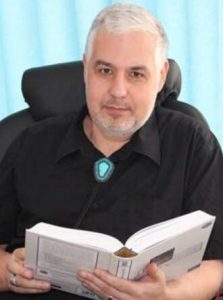
Prof. Herwig Unger
Title: Brain Inspired methods for Natural Language Processing
Bio:
Abstract:

Prof. Phayung Meesad
Title: The Trends and Challenges in Big Data Analytics
Bio:
Phayung Meesad currently is an Associate Professor at the Faculty of Information Technology and Digital Innovation, King Mongkut’s University of Technology North Bangkok (KMUTNB), Thailand. Phayung received a Bachelor of Science in Technical Education (Teaching in Electrical Engineering), from KMUTNB in 1994. He received a Master of Science (MS) and Doctor of Philosophy (Ph.D.) in Electrical Engineering from the School of Electrical and Computer Engineering, Oklahoma State University (OSU), Stillwater, USA, in 1998 and 2002, respectively. His research interests are Big Data, Business Intelligence, Computational Intelligence, Artificial Intelligence, Machine Learning, Deep Learning, Data Analytics, Data Science, Data Mining, Digital Signal Processing, Image Processing, Time Series Analysis, and Natural Language Processing. He has been general chair and co-chair of many international conferences. He has published and contributed research in Scopus indexed international conferences and journals more than 80 publications.
Recent Publications
Doan, V.T., Khang, V.Q.H., Nguyen, H.H.C., Huynh, C.P., Meesad, P., (2020). “A Novel Solution for Virtual Server on the Data Consistency Maintenance in Cloud Storage Systems,” Advances in Intelligent Systems and Computing, 936, pp. 227-234.
Jaikrishnan, S.V.J., Chantarakasemchit, O., Meesad, P., (2019), “A Breakup Machine Learning Approach for Breast Cancer Prediction,” 11th International Conference on Information Technology and Electrical Engineering, ICITEE 2019.
Vidanelage, H.M.M.H., Tasnavijitvong, T., Suwimonsatein, P., Meesad, P., (2019), “Study on Machine Learning Techniques with Conventional Tools for Payment Fraud Detection,” 2019 11th International Conference on Information Technology and Electrical Engineering, ICITEE 2019.
Suksakaophong, P., Meesad, P., Unger, H., (2019), “ARMFEG: Association Rule Mining by Frequency-Edge-Graph for Rare Items,” Advances in Intelligent Systems and Computing, 769, pp. 13-22.
Bo, M. M., Meesad, P. (2018), Mining Patterns in Housing Characteristics of Migrants, 18th International Symposium on Communications and Information Technologies (ISCIT 2018), Sukosol Hotel, Bangkok, Thailand, 26-28 September 2018.
Rasel, R.I., Sultana, N., Akhter, S., Meesad, P. (2018), “Detection of Cyber-Aggressive Comments on Social Media Networks: A Machine Learning and Text Mining Approach,” 2nd International Conference on Natural Language Processing and Information Retrieval (NLPIR 2018), Riverineplace, Nonthaburi, Thailand, 7-9 September 2018.
Suksakaophong, P., Meesad, P., Unger, H. (2018), “ARMFEG: Association rule mining by frequency-edge-graph for rare items,” 14th International Conference on Computing and Information Technology (IC2IT 2018), Shangri-La Hotel, Chiang Mai, Thailand, 5-6 July 2018.
Jitsakul, W., Meesad, P., Sodsee, S. (2018), “Enhancing comment Feedback classification using text classifiers with word centrality measures,” proceedings of the 2nd International Conference on Information Technology (INCIT 2017), pp. 1-5.
Rasel, R.I., Sultana, N., Meesad, P. (2018), “An application of data mining and machine learning for weather forecasting,” Advances in Intelligent Systems and Computing, 566, pp. 169-178.
Kubek, M. M., Meesad, P., Unger, H., (2017), “User-based document ranking,” ACM International Conference Proceeding Series, Part F133874, pp. 119-123.
Tapsai, C., Meesad, P., Haruechaiyasak, C. (2017) “Natural language semantic model for arithmetic sentences,” ACM International Conference Proceeding Series, Part F133874, pp. 175-179.
Boonyopakorn, P., Meesad, P. (2017) “The evaluated measurement of a combined genetic algorithm and artificial immune system,” International Journal of Electrical and Computer Engineering, 7(4), pp. 2071-2084.
Boonyopakorn, P., Meesad, P. (2017) “A hybrid immune genetic algorithm to solve university time table problems,” Walailak Journal of Science and Technology, 14(10Special Issue), pp. 825-835.
Boonyopakorn, P., Meesad, P. (2017) “The performance evaluation of a hybrid immune genetic algorithm based on mathematical functions,” 20th International Computer Science and Engineering Conference: Smart Ubiquitous Computing and Knowledge, ICSEC 2016, art. no. 7859880.
Kadmateekarun, P., Meesad, P., Nuanmeesri, S. (2017) “Comparing techniques for sentiment analysis in cosmetic industry from Thai reviews videos,” Journal of Engineering and Applied Sciences, 12 (2), pp. 397-403.
Mahmud, M.S., Meesad, P. (2016) “An innovative recurrent error-based neuro-fuzzy system with momentum for stock price prediction” Soft Computing. 20 (10), pp. 4173-4191.
Li, J., Meesad, P. (2016). “Combining Sentiment Analysis with Socialization Bias in Social Networks for Stock Market Trend Prediction” International Journal of Computational Intelligence and Applications. 15 (1), 16 p.
Long, N.C., Meesad, P., Unger, H. (2015). “A highly accurate firefly based algorithm for heart disease prediction,” Expert Systems with Applications, 42 (21), art. no. 10101, pp. 8221-8231.
Mahmud, M.S., Meesad, P. (2015). “An innovative recurrent error-based neuro-fuzzy system with momentum for stock price prediction,” Soft Computing 20(10), pp. 4173-4191
Hieu, D.V., Meesad, P. (2015). “Fast K-Means clustering for very large datasets based on mapreduce combined with a new cutting method,” Advances in Intelligent Systems and Computing, 326, pp. 287-298.
Long, N.C., Wisitpongphan, N., Meesad, P. Unger, H. (2014). “Clustering stock data for multi-objective portfolio optimization,” International Journal of Computational Intelligence and Applications, 13 (2), art. no. 1450011.
Buathong, W., Meesad, P. (2014). “Double linear support vector machine for dimensionality reduction,” Research Journal of Applied Sciences, 9 (4), pp. 208-213.
Thanh, H. T. P., Meesad, P. (2014). “Stock Market Trend Prediction Based on Text Mining of Corporate Web and Time Series Data,” Journal of Advanced Computational Intelligence and Intelligent Informatics, 18 (1), pp. 22-31.
Thammasiri, D., Delen, D., Meesad, P., Kasap, N. (2014). “A critical assessment of imbalanced class distribution problem: The case of predicting freshman student attrition,” Expert Systems with Applications, 41 (2), pp. 321-330.
Abstract:
Data contain hidden knowledge applied for decision-making in a wide variety of applications such as businesses/manufacturing selections and other decision-making tasks in governmental sections. Data mining techniques has been implemented to extract knowledge from small raw datasets; however, the knowledge results from small data may not be enough for a given task, as it does not cover the universe of domain of interests. This may be due to an under-fitting problem that is too few samples in the domain of interests. So big data should be applied if they are available. As big data are now more and more exponentially increase due to the rapid growth of the Internet of Things, manufacturing data, machine-generated data, and social network user-generated data. Nevertheless, mining big data is not easy; it is required suitable knowledge about big data analytics. This keynote talk is about the big data analytics problems and challenges including big data ecosystems and technologies, big data mining techniques, and machine learning in big data problems. The talk will give brief reviews state-of-the-art of deep learning for big data including Convolutional Neural Network (CNN), Recurrent Neural Network (RNN), Long Short-Term Neural Network (LSTM), and Gated Recurrent Unit (GRU). Applications of deep learning and big data on Image Processing and Natural Language Processing will be also covered.
 Assistant Prof. Dr. Waralak Vongdoiwang Siricharoen
Assistant Prof. Dr. Waralak Vongdoiwang Siricharoen
Title: Using Personas as Empathizing and Defining Methods of Design Thinking Process
Bio:
Waralak Vongdoiwang Siricharoen is Assistant Professor of Faculty of Information and Communication Technology, Silpakorn University, Bangkok, Thailand. She received her master degree in Business Administration with Computer Information Systems Certificate in 1999 from University of Southern New Hampshire (New Hampshire College), NH, USA. And she received her Doctoral Degree of Technical Science in 2005 from Asian Institute of Technology (AIT), Thailand. Her previous works focus on creating the object models from ontologies. Her works have been reported in peer–reviewed papers published in international journals, conference proceedings, and books. Her research area specialists are ontologies, database technology, software engineering, object oriented, human computer interaction, etc.
Abstract:
Exploring user attitudes and behaviors within the domain of interests helps the user experience team to match the user with a deeper understanding. The mapping process also reveals any gap in existing user data. Design thinking is the ground-breaking and cooperative approach to problem-solving that puts the user first to make user-centered products and services. There are many various design thinking activities that use to generate a thoughtful of the users or customer, including the conception of personas. This paper revisits the concept of persona and draws the connection of using empathy map to build persona within the design thinking process. Also showing the benefit of empathizing method to construct the effective persona.This can be used for the benefit in Human Computer Interaction(HCI) designing processes or marketing analysis.

